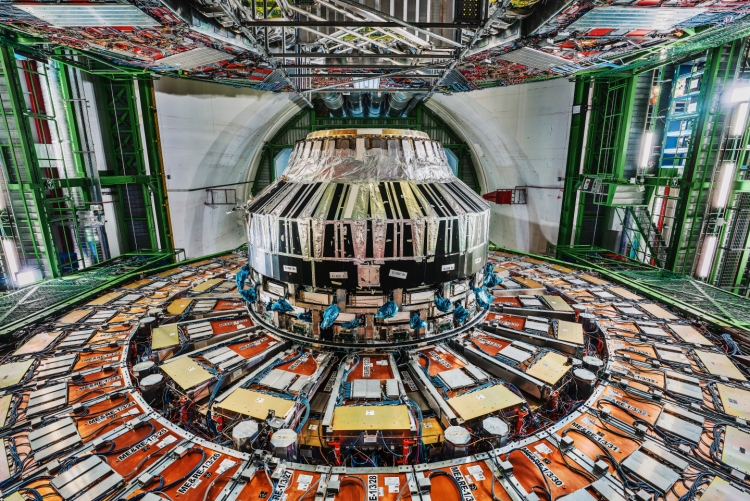
The year 2020 is coming to an end; despite its exceptional difficulties and challenges caused by the world-wide COVID-19 pandemic, the CMS collaboration reached many important milestones during this period. This overview gives a brief glimpse of some of the important achievements reached by CMS this year.
The CMS Collaboration completed another two-year cycle in its traditional top management rotation. Starting from the 1st of September 2020 until August 2022, the new spokesperson Luca Malgeri and the two deputies Gautier Hamel de Monchenault and Jim Olsen will lead more than 5000 people working at CMS.
CMS celebrated the summer solstice one day early, on June 19th, with the submission of the 1000th paper to a refereed journal: a few months later, on the 24th November, the announcement that 1000 papers passed peer review and were accepted for publication, an accomplishment never before reached by a high energy physics experiment. These papers constitute an exceptional legacy to humanity, and many of them provided outstanding breakthroughs in our quest to understand the Universe.
In August, CMS reported the first evidence that the Higgs boson decays to two muons, another important step in the long path towards the full understanding of this fascinating particle first discovered in 2012 by CMS and ATLAS. Since only one out of around five thousand bosons decays to dimuons, this measurement is a remarkable milestone, reached well before early expectations thanks to vastly improved analysis techniques and a superb performance of the CMS muon tracking capabilities.
To find more of our physics briefings from throughout this year, click here.
Nan and Stephane walk us through the measurement and why it is an important step to understanding Higgs production. This result was found five years earlier than expected because of several improvements which were made.
Also in August, CMS released a new batch of open data. With this release, CMS has brought all proton-proton collision data recorded in 2010 and 2011 into the public domain, free to use and available to anyone. This is the fifth data release by CMS since 2014 and adds to the earlier open data from the LHC’s first data-taking period (“Run1”), from 2010 to 2012. In December, the CMS open data was even further expanded with the first release of Run 1 heavy-ion data, providing the option to study the quark-gluon plasma to citizen scientists and in education.
During this year of Long Shutdown 2 (LS2) CMS groups continued their work on the many upgrade activities needed to prepare CMS for the Run3 at the LHC. At the same time the detector improvements are looking even further forward in preparation for the upgrade to High Luminosity LHC (HL-LHC), when the Large Hadron Collider will be upgraded to significantly increase the luminosity (number of potential collisions) by a factor of 10 beyond the LHC’s design value.
Among the 40 million collisions of proton bunches produced by the LHC at CERN per second, the CMS experiment relies on a sophisticated two-level triggering system to identify and retain the collisions with potential physics interest. The first level (L1) of the trigger is composed of custom electronics boards to be able to handle the 2 Tb/s (Terabits per second) information generated by the detector. The CMS L1 Trigger team is engaged in preparation for Run3 and planning for the future with an even more advanced trigger system based on modern technologies. To achieve the goals of the HL-LHC program, the Phase-2 upgrade of the L1 system utilizes technological advances to implement sophisticated algorithms, including machine learning to explore the unknown.
The CMS Muon System has also gone through major upgrades this year preparing for Run3 and the HL-LHC. In September the first Gas Electron Multiplier (GEM) station was completed. With the full installation of the first half of the detector (negative endcap), this year the remaining half of the detector was completed (positive endcap). This is an important milestone for the full CMS collaboration, as it represents the first brand new detector installed as part of Phase-2 upgrade, and introduces cutting-edge technology, the GEMs, to complement the Muon system.

Final GEM installation in September 2020. Credit: CERN, N. Caraban Gonzalez.
In October, the installation of a brand new protection system for the central muon chambers was finished, aimed to keep the outer Drift Tube chambers shielded from background radiation present in the experimental cavern during collisions. The installation of this special shielding system has been completed this year after more than one and a half year of installation. The completed structure will allow operating the detectors in a much lower radiation environment during Run3 and beyond.
To cope with the HL-LHC increase of luminosity the Cathode Strip Chambers (CSC) need upgraded electronics capable of withstanding the higher particle rate and radiation conditions. Most of the electronics upgrade of the CSCs is happening during LS2 since the chambers will not be accessible during Long Shutdown 3, after Run3. In order to perform this upgrade, 180 CSC chambers (one-third of the whole detector) are being uninstalled and brought up to a dedicated surface lab for refurbishment.
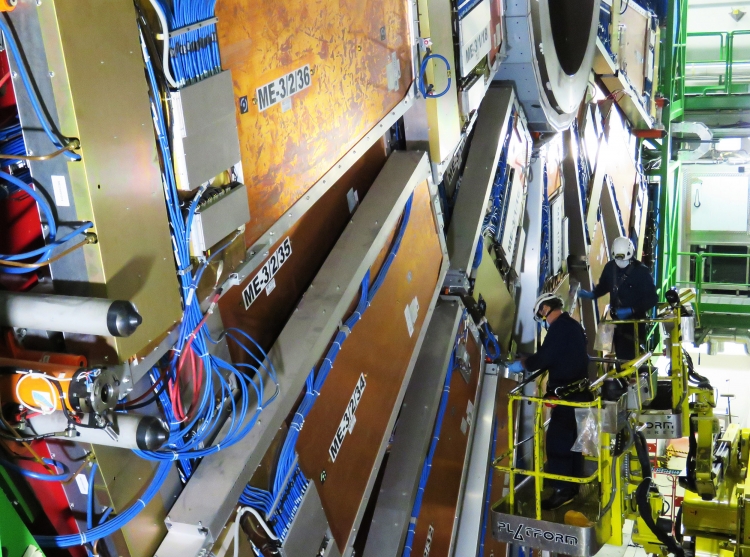
Extraction of a Cathode Strip Chamber in the CMS cavern. (2020) Credit: J. Myhre
The CSC upgrade also involved their fellow Resistive Plate Chambers (RPC) detectors in the external disks of CMS or “endcaps”. 72 Super Modules from the two RE4 stations had to be uninstalled for maintenance, but also to create the space for the CSC upgrade. The extraction of such a massive chamber was performed for the first time. The handling of the very delicate Super Modules of about 4 meters lenght and with a weight of 230 kg each was challenging. The revalidation of all 72 detectors was performed on the surface in a newly built lab applying specific Quality Control tests. Half detectors were reinstalled at the end of 2019 and the remaining half end of 2020. Last intervention consisting of reinstallation of 36 Super Modules was performed in the month of November 2020.
After the successful upgrade of the Hadron Calorimeter (HCAL) barrel detector in 2019, the main goal of the HCAL project has been to prepare to collect the best possible physics data during Run3. Throughout 2020, HCAL has taken advantage of every opportunity to exercise all detector components during dedicated detector commissioning periods. Many improvements have focused on streamlining the systems used to control HCAL to improve stability and minimize operational downtime. A novel HCAL initiative is to use Machine Learning techniques to identify subtle anomalies in the on-detector electronics quickly.
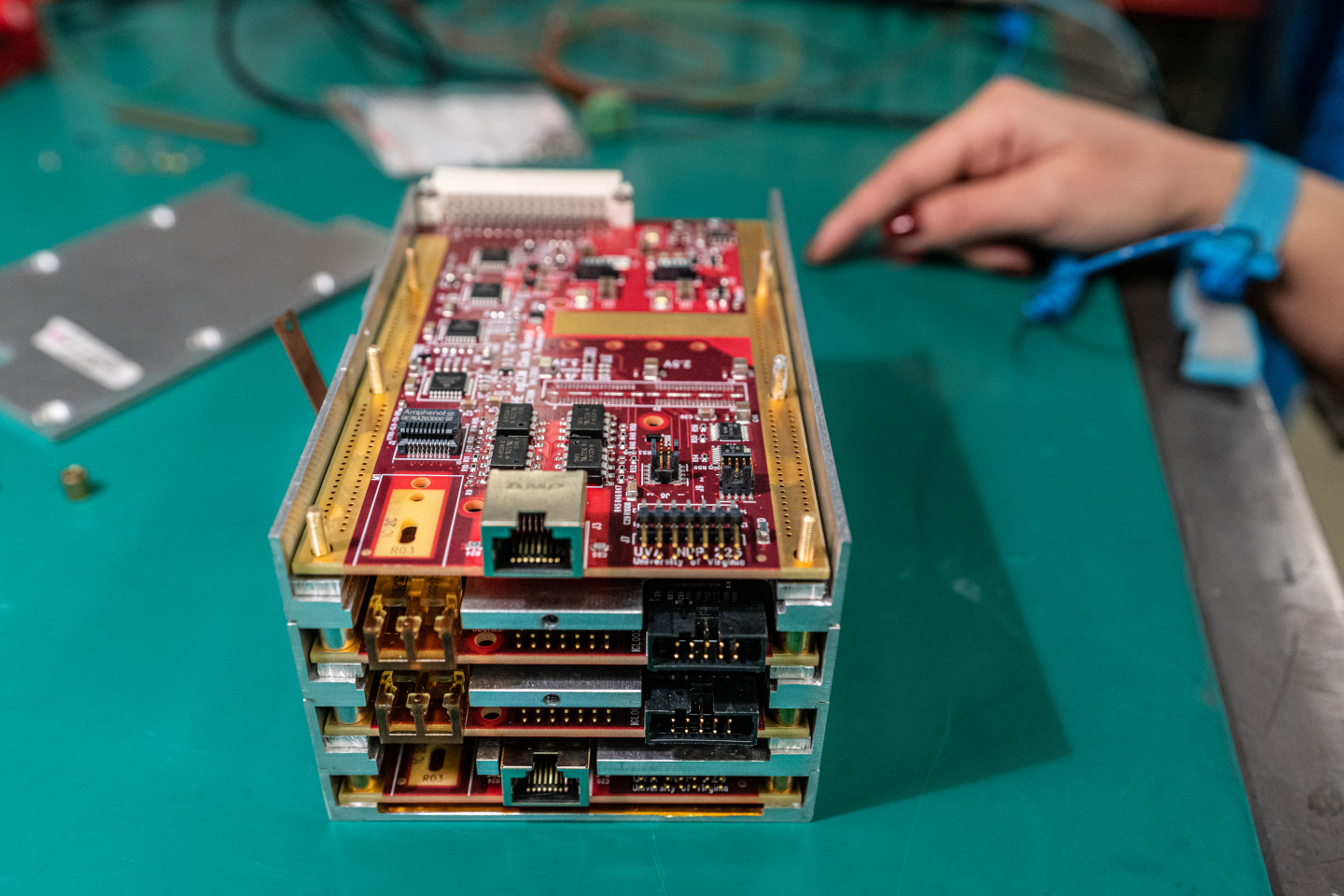
Open HCAL Endcap Clock, Control, and Monitoring unit (HEngCCM). The open face reveals one of the two clock cards. This is one of the 36 units that will return underground in 2021 with enhanced cooling, to ensure healthy performance in Run 3. Credit: S, J. Hertzog
The Electromagnetic CALorimeter (ECAL) team has completed an important upgrade of the detector control and safety systems, which is now faster and more robust. Additional work has been done to update the data acquisition system and to maintain the laser monitoring system. The detector has been successfully operated during short periods of cosmic-ray data taking, proving that ECAL is ready for the Run3. In preparation for the high-luminosity upgrade of the LHC, ECAL has performed the test of first prototypes of the electronics required to read and digitize the signals produced by electrons and photons in the Lead-Tungstate crystals of the calorimeter. The way for a successful upgrade is paved.
The Tracker project marked the end of 2020 with the completion of the new Layer-1 barrel pixel detector. Continued software development and this year's work on the forward pixel and strip tracker detectors ensures that the Tracker will meet the demanding performance requirements of Run3. The Tracker upgrade project met many critical milestones this year, including the start of production procedures for specialized materials and readout electronics for the HL-LHC Tracker detector. The production of Phase-2 Tracker sensors has started, with the first devices undergoing testing at collaborating institutions worldwide.
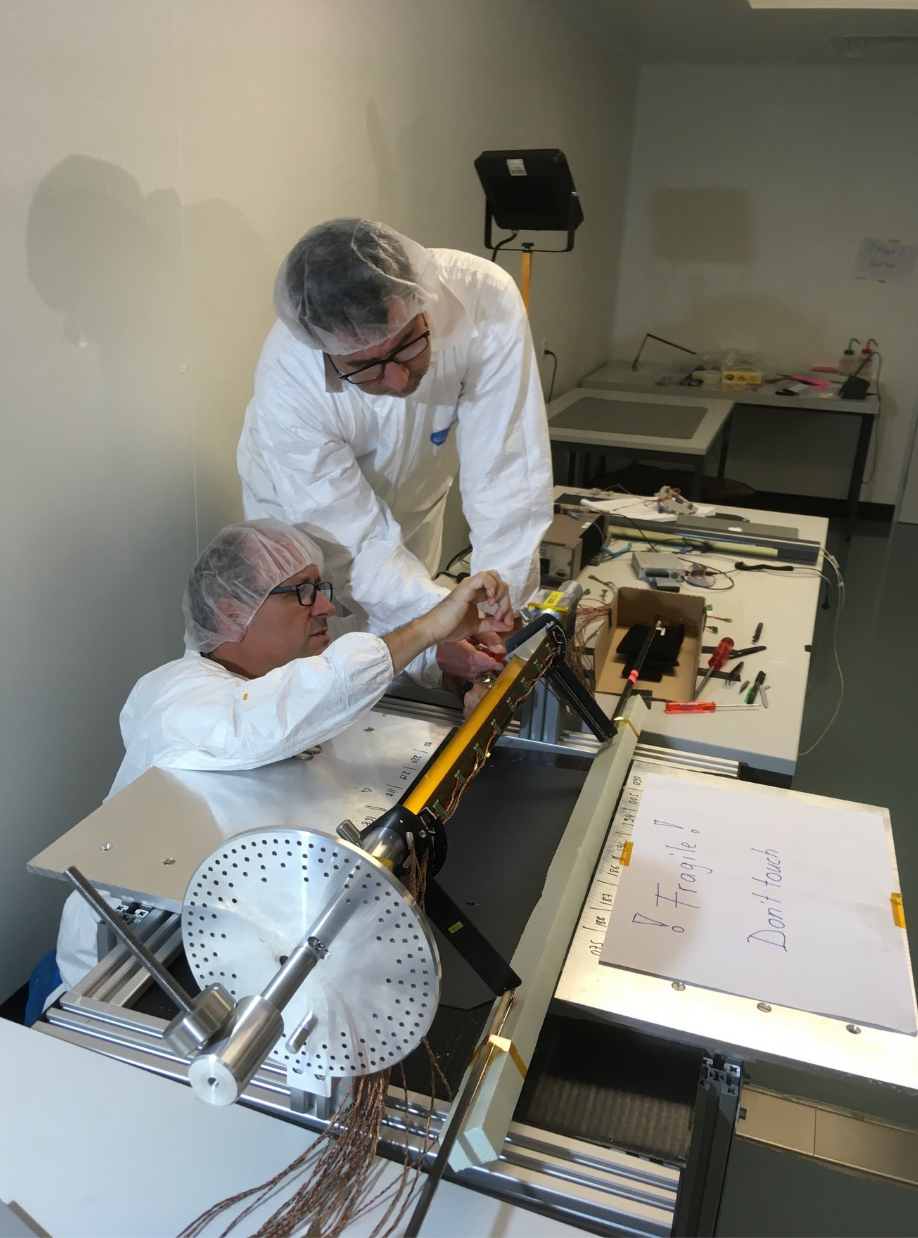
Cable dressing of the new Layer-1 barrel pixel detector. Paul Scherrer Institute in Villingen, CH. Credit: D. Kotlinski
This year has also been an exciting year for the high-granularity calorimeter (HGCAL) project. Prototyping and qualification is in full swing of many detector parts. Full-sized silicon sensors are undergoing thorough testing, including their resistance to radiation. Prototype silicon and SiPM-on-tile modules have been tested. The overall electronics system integration has been a major focal point in 2020 for both on- and off-detector systems for the trigger, data acquisition system, power, and control systems. The corresponding electronics boards have also been prototyped. Experts from outside the project have validated the heavy mechanics, and prototypes have been made of high-precision plates for the particle absorber layers and cooling plates. Simulation and reconstruction activities are also progressing very well.
The MIP timing detector (MTD) will measure the precise arrival time of charged particles to reject backgrounds and clean up the physics signals for the HL-LHC. After CERN approval of the MTD project last fall, the year started with Timing Days at CERN and a fantastic ETL Modules workshop in Torino in February. The rest of the year had most of the MTD group working from their homes and labs, prototyping design choices, developing the fabrication processes, making significant progress with the front-end ASICs, prototyping readout electronics and establishing the readout chain, and getting close to the final design and footprint of this novel detector.
The Precision Proton Spectrometer (PPS) team worked on multiple fronts throughout 2020. Final calibrations were derived for the large dataset collected during the Run2, enabling analyses of photon-photon and other exclusive interactions, with much larger event samples and collision energies than any previous study. Preparations for Run3 continued, with infrastructure and detector developments that will allow time-of-flight measurements of forward protons with unprecedented precision. A proposal was prepared for a PPS upgrade targeting HL-LHC running.
2020 has been a rebuilding year for the Beam Radiation, Instrumentation, and Luminosity (BRIL) Project. Two of the Phase 1 BRIL luminometers that are installed very close to the beam line and have inevitably received high radiation doses during Run2 and are being replaced for Run3. Both the new Pixel Luminosity Telescope (PLT) and the new Fast Beam Conditions Monitor (BCM1F) systems are on target to be installed in summer 2021. BRIL is also looking to the future, and is in full swing refining the BRIL strategy for Phase-2 upgrades, with a plan for a publication of a Technical Design Report in 2021. In addition to the ongoing hardware work, BRIL and the CMS Luminosity Physics Object Group have put together a world record-breaking luminosity publication for the 2015-16 data that will see the overall systematic uncertainties below the 1.5% level. Some work done to understand common beam related systematics has been achieved within a very collaborative environment in the LHC Luminosity Calibration and Monitoring Group, where all LHC experiments and the LHC machine colleagues share insight and technical information to address systematics uncertainties in the luminosity calibration of common interest, and CMS wishes to thank all contributing colleagues to this productive and active forum.
The COVID-19 pandemic changed the modus operandi of many organizations; tele-working changed from being the exception to being adopted where possible, and many people embraced tasks to help local communities and the rest of the world. Volunteers within CMS started the Better Than Nothing (BTN) mask project. This project aimed to freely supply recyclable cotton masks to local charity organisations. By July, the project had produced more than 3000 masks in about 9 weeks of full speed production. Additionally, the CMS Collaboration helped to fight against COVID-19 in many other ways, including the design and production of face shields and masks for the broader CERN community and local area, and in the development of simple, inexpensive and fast-to-build mechanical ventilators, such as the Mechanical Ventilator Milano and the Princeton Open Ventilation Monitor.
Last but not least, CMS members, together with the LHC computing community at large, engaged with the Folding@Home project in mid March. The CERN community has given enough computing (nearly 100k computing cores on average) to be a major part of the F@H network, including 30k from the CMS high-level trigger farm at Point 5, rapidly rising to one of the top 100 absolute contributors to the project (data from May 2020).
Despite being faced with exceptional challenges in 2020, the CMS collaboration succeeded in making remarkable advances in all its projects and welcomes 2021 with a strong motivation.
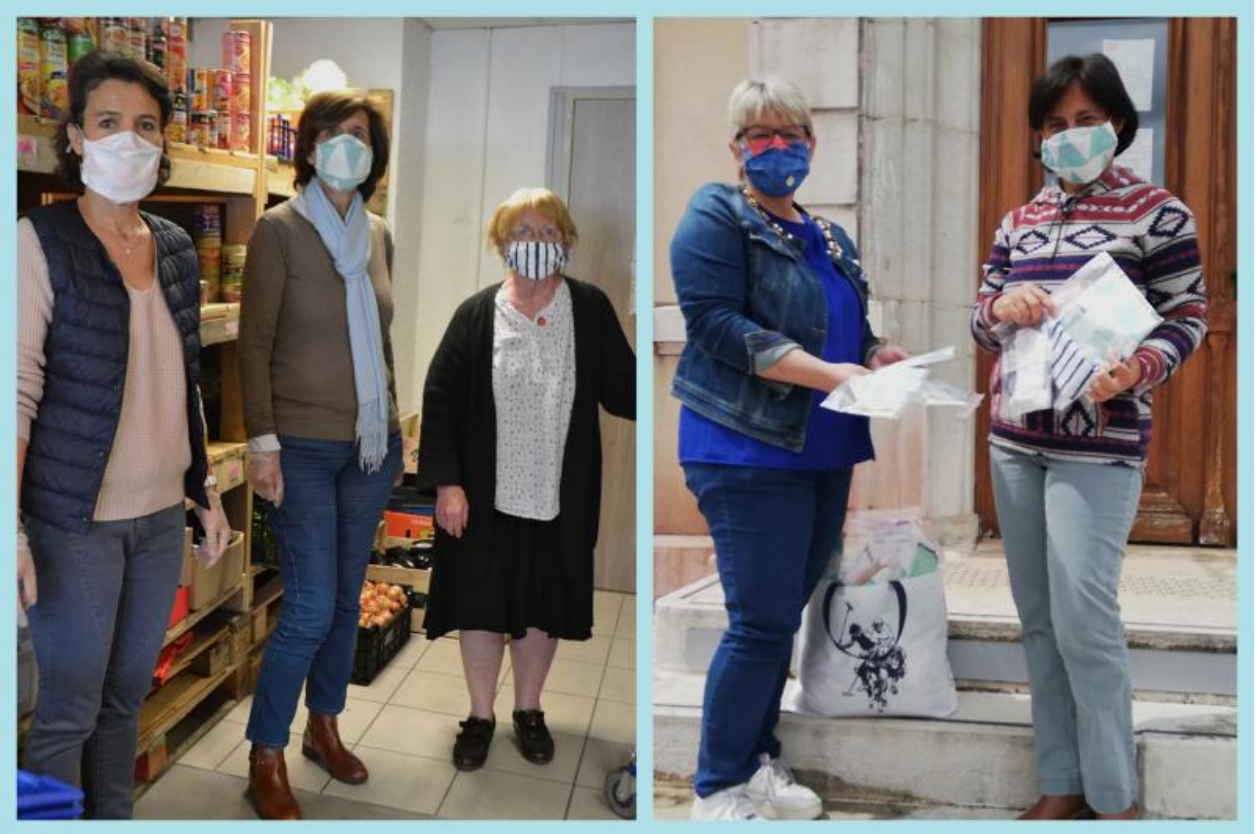
Left: BTN masks in Resto du Coeur of Ferney Voltaire; Right: 300 masks delivered to CCAS in Thoiry (picture to include masks and F@H diagram)
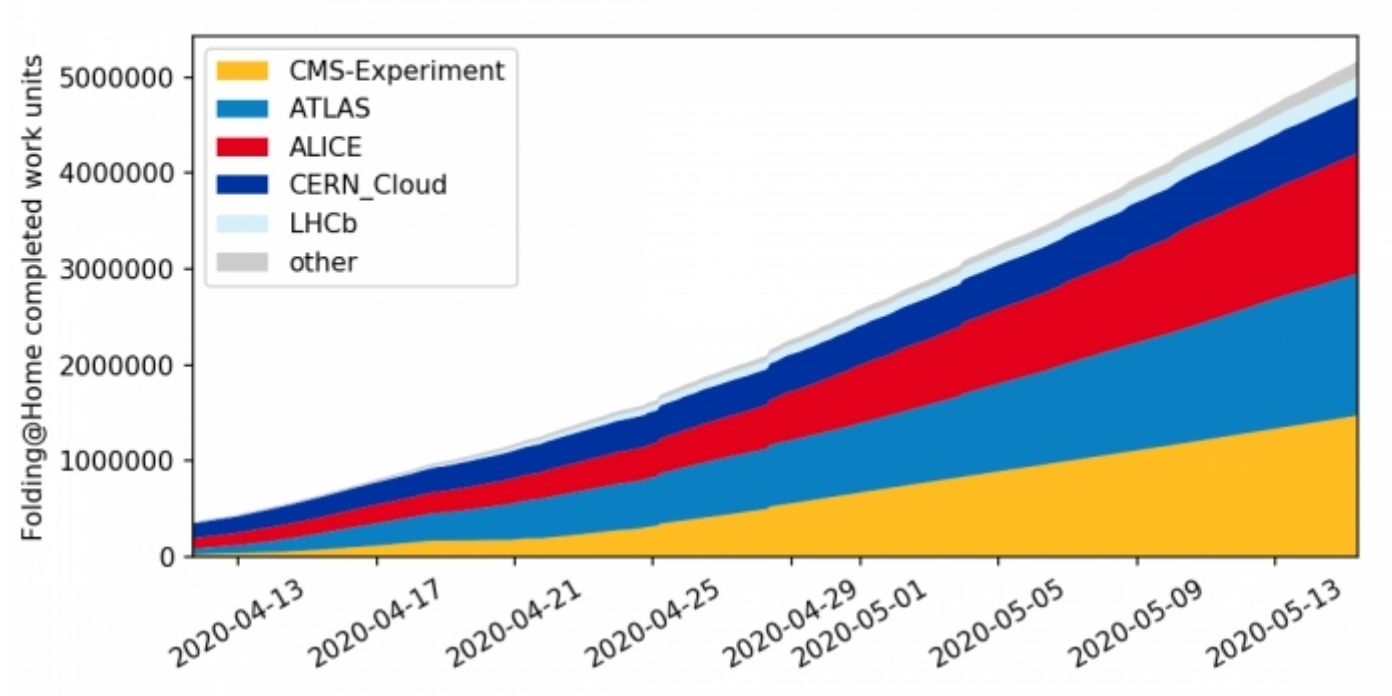
LHC computing contribution to the Folding@Home project: graph credits Andrea Bocci

